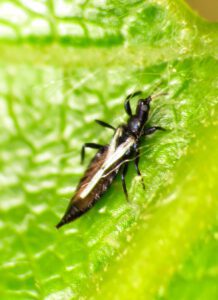MEET the PESTS:

(thr ᐧ ih ᐧ ps)
All About Thrips
Thrips, an insect in the Thysanoptera order, are tiny, slender insects with fringed wings that feed on the plant by piercing the outer layer of the leaf and sucking the contents out. They can be particularly destructive and move between plants with ease—while they cannot fly, they can leap about two feet.
There are thousands of species of thrips, some of which are actually beneficial and predatory! The ones that cause damage in our house plants tend to belong to the family Thripidae, of which there are around 300 species.
Fun fact: the singular of thrips is thrips!
The Thrips Life Cycle

Understanding the thrips life cycle is essential to treating them successfully.
Thrips adults lay eggs within the leaf tissue of the plant. As the eggs hatch, larvae emerge and eat their way out of the leaf (causing distinctive damage marks). The larvae feed on the plant for about five days*.
For many thrips species, once the larva matures through two more life stages, it will drop down into the growing medium to pupate. The pupal stage takes about three days*, and then the thrips will emerge from the growing medium as the long, black, winged adult where the cycle starts again. The adults move quickly and jump when approached, almost like fleas.
A full thrips life cycle can take anywhere from just a few days to up to 45 days* to complete.
*Lengths of time presented in this summary are averages and will vary depending on environmental conditions.
What thrips look like

Thrips adults are fairly distinctive: sleek and slender black or brown insects that look somewhat like a pencil shaving. They tend to stand out from the leaf surface.

Thrips larvae are much smaller than the adults and tend to be a clear, yellowish color. They are often sedentary and resemble specks of dust. To distinguish them from dust, try poking them to see if they move; if it’s a thrips larvae, it will wriggle like a worm or begin to crawl away. Larvae often hide in the crevices of a plant, or along the leaf veins.
Inspecting for Thrips
Thrips are excellent at hiding. By the time you are seeing the adults, you have a lot of thrips. You’re more likely to notice the damage caused by thrips (see below) before you see the insects themselves.
When inspecting your plant for thrips, be sure to pull back where the leaves meet the stem or any leaf-like material attached to the base of the plant. They also often hide where the leaves meet, in divots in the leaves, or in papery debris (like old leaf sheaths). Peel and remove dead leaves as you inspect.
Examples of Thrips Damage
Because thrips are so small and good at hiding, the damage they cause is often the first indication you have thrips. Monitor your plants and treat at the first sign of damage—the sooner you start treatment, the easier it is to get rid of them!
Thrips damage most often presents as:
- Coppery streaks or circles on the backs of older leaves.
- Indentations on the leaves.
- Yellowing and browning around the leaf edges.
- “Fish scale” type pattern of damage.
- New leaves that unfurl deformed or damaged, or struggle to unfurl altogether.
- Round holes or streaks in new growth.
- Tiny, raised dark brown or black spots on the leaves that wipe off; they may also appear wet. (This is thrips poop!)
^ ^ click to jump to our thrips treatment plans ^ ^






